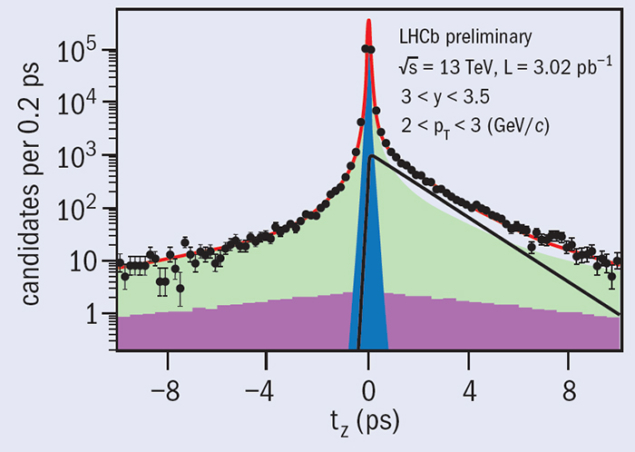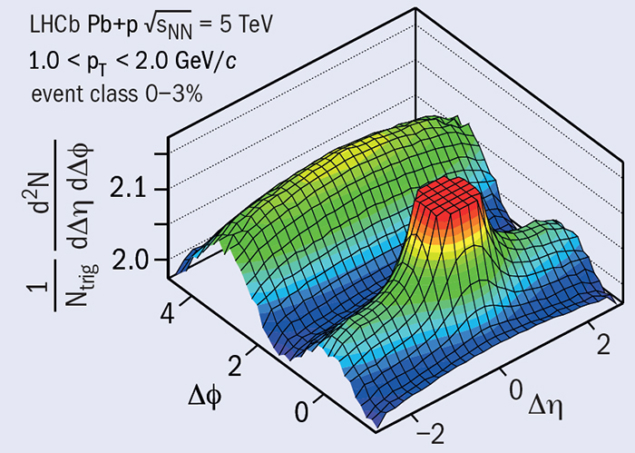
At EPS-HEP2015, the LHCb collaboration presented the first measurement of the J/ψ production cross-section in proton–proton (pp) collisions at 13 TeV. Using this measurement, they also determined the b-quark cross-section at this new, higher energy.
J/ψ mesons can be produced both “promptly”, in the pp collision, and as a product of decays of B hadrons, dubbed “J/ψ-from-b”. The two components are visible in figure 1, which shows the J/ψ decay-time distribution with respect to the pp collision time. The black points with error bars show the data, the solid red line indicates the best fit to the data, and the prompt J/ψ contribution is shown in blue. The black line indicates the J/ψ-from-b contribution, which falls exponentially with a time constant characteristic of the lifetime of B hadrons.
While the prompt J/ψ cross-section is interesting for constraining QCD models, the J/ψ-from-b cross-section is used to compute the b-quark pair total cross-section. The data at 13 TeV confirm the expected rise of the B-particle production rate of about a factor two with respect to 7 TeV. This increase will enable LHCb to obtain even more precise, interesting and, hopefully, surprising results in LHC Run 2.

This analysis was the first to benefit from a new scheme for the LHCb software trigger that was introduced for Run 2. Splitting the event selection into two stages, it allows alignment and calibration to be performed in real time after the first stage of the software trigger and then used directly in the second stage. The same alignment and calibration information is propagated to the offline reconstruction, to ensure consistent and high-quality particle-identification information in the trigger and offline. The identical performance of the online and offline reconstruction achieved in this way offers the opportunity to perform physics analyses directly using candidates reconstructed in the trigger – the online reconstruction is used, for example, in the J/ψ cross-section measurement. The storage of only the triggered candidates leads to a reduction in the event size of an order of magnitude, permitting an increased event rate with higher efficiency.
LHCb also presented the determination based on Run 1 data of the Cabibbo–Kobayashi–Maskawa (CKM) matrix element |Vub|, which describes the transition of a b quark to a u quark. The measurement – published during the conference in Nature Physics – was made by studying a decay Λ0b baryon, Λ0b → pμ– νμ (LHCb 2015a). The measurement of decays involving a neutrino is very challenging at a proton collider, and it was quite a surprise that this measurement could be done.

Measurements of |Vub| by previous experiments had returned two sets of inconsistent results, depending on the method used. Inclusive determination using all b → ulν transitions where l is either a muon or an electron give values of |Vub| above 0.004, while exclusive determinations, mainly from B → πlν, yield values around 0.003. This could be explained by a new particle, in addition to the W boson, contributing to the quark transition with a right-handed current. LHCb’s new measurement is of the exclusive category, but is the first to involve a baryon decay and hence a spin-1/2 particle. The result is |Vub| = (3.27±0.15±0.16±0.06) × 10–3, where the uncertainties are experimental, related to the theoretical calculation, and to the value of |Vcb|, respectively. This number agrees with previous exclusive determinations and is inconsistent with the hypothesis of new right-handed currents. So it still leaves the puzzle of why the inclusive and exclusive measurements do not agree. Further intensive research, both at the experimental and theoretical level, will continue to try to understand this disagreement.
While the above measurement constrains one side of the CKM unitarity triangle, the other (the third being unity) is best constrained by the B-meson oscillation frequency. LHCb presented the most precise measurement to date at the conference, using semileptonic B0 decays. The result of (503.6±2.0±1.3) ns–1 is consistent with, but more precise than, the world average (LHCb 2015b).
In other highlights from Run 1, the collaboration reported new results on long-range correlations in proton–lead collisions. LHCb’s latest measurements show that the so-called “ridges” seen in the most violent collisions span across even larger longitudinal distances, as figure 2 shows at Δφ = 0 below the (truncated) peak at (0,0). This is the first time that the effect has been seen in the forward direction (LHCb 2015c). Moreover, because of its acceptance, the LHCb experiment distinguishes between configurations where the lead-ion enters from the front and those where it is the proton. Somewhat unexpectedly, the ridge is seen in both cases.








